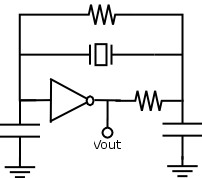Are there any high-stability oscilators, which are not crystal based, given that temperature is stable down to 0.01 C and voltage down to 0.001V?
Will LC-based oscillator be able to show performance comparable to crystals in such conditions (probably in wierd variants like LC-opamp-LC-opamp-LC-opamp… so that any energy loss on each stage is recovered and we are getting narrower bandwidth)?
Price is not limited here, to a some degree (so brand new atomic clocks are above the budget, but 100$ for peltier/oven & parts is ok).
From my (naive) point it seems that it should be possible to achieve better short & long-term stability than with crystals…

Best Answer
Superb mechanical construction of the inductor is a major factor. See Czech Tesla report cited below for specific advice.
If you can track down this 1941 [!!!] original and/or the many derivatives based on it using both "valves" and 'solid state" circuits you will probably find circuits with performance about as good as you can get.
"E. O. Seiler, "A Low-C Electron-Coupled Oscillator," QST, Nov 1941."
A circuit based on Seiler's work was published in QST with , I think, a title like "A synthetic rock" or "The synthetic rock. (Rock == crystal).
One reference noted that the oscillator output was designed to be plugged into a crystal socket and when used at eg 12 MHz to provide the reference fquency for a 2 m,etre band (144-148 Mhz) transmitter, produced a signal which was zero beat stable for hours ata time when compared with a crystal controlled test unit. Zero beat stable means drift is within a few Hz at most as otherwise you hear "rumbling" as the two signals heterodyne.
I don't speak or read Croatian and gargoyle was having a bad day but I believe the circuits below are based on Seiler's ideas. See pages 147-148 here. Translation to English (unless you read Croatian) looks worthwhile. Many other related circuits there too. These may come from US "hams' W8PK & W3EB.
Note that these two circuits do NOT look overly special. I think a significant part of the "trick" is in the relative (lack of) loading of the tuned circuit.
This mentions the Synthetic Rock in passing, with approval.
Valuable albeit old !!!
Resources for Understanding Oscillators {2003} - with references to MUCH older material.
Look for Seiler references.
The following are from the above reference -
E. O. Seiler, "A Low-C Electron-Coupled Oscillator," QST, Nov 1941.
W. B. Bernard, "Let's Increase V.F.O. Stability," QST, Oct 1957.
J. Vackar, "LC Oscillators and their frequency stability," Tesla Tech. Reports, Czechoslovakia, Dec 1949.
1949 original of the above report in Czech. Superb][(http://www.scribd.com/doc/62276627/Vackar-wholepaper)
Starts with a description of mechanical requirements for high stability.
J. K. Clapp, "Frequency Stable LC Oscillators," Proc. IRE, Aug 1954.
The above suggests that the Vackar oscillator is potentially more useful.
See refs here Discrete Oscillator design- Rhea on page 261.